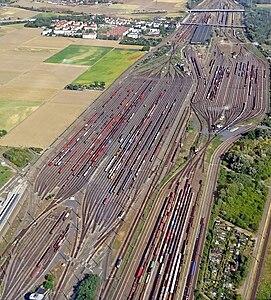In the intricate web of transport and shipping logistics, one crucial component stands out like a well-orchestrated symphony: the classification yard. This often overlooked but essential facility serves as the nerve center of connecting trains, trucks, and ships, ensuring that goods reach their destinations efficiently and seamlessly. Join us as we delve into the inner workings of the classification yard and discover the vital role it plays in the world of transportation and shipping.
Key Components of a Classification Yard
A classification yard is an essential part of the logistics, transport, and shipping industry, as it helps efficiently sort and organize trains and their cargo. There are several key components that make up a classification yard, each playing a crucial role in the smooth operation of the facility.
- Receiving Yard: This is where incoming trains are sorted based on their destination and the type of cargo they are carrying. Trains are broken down into individual cars, which are then grouped together to form new trains heading to specific locations.
- Classification Bowl: The heart of the classification yard, the classification bowl is a maze of tracks where cars are sorted and rearranged. Here, cars are pushed over hump tracks, which use gravity to guide them to the appropriate track in the yard.
- Departure Yard: Once cars have been sorted and grouped together, they are assembled into outbound trains in the departure yard. These trains are then ready to depart for their final destinations, carrying a mix of goods and products.

Optimizing Efficiency in Logistics Operations
One key strategy for streamlining logistics operations is to implement efficient classification yards. These yards serve as central hubs for sorting and organizing incoming and outgoing freight, allowing for quicker and more organized transport of goods. By optimizing the layout and workflow of a classification yard, logistics companies can reduce bottlenecks, minimize delays, and improve overall efficiency.
Utilizing advanced technology such as automated sorting systems and RFID tracking can further enhance the efficiency of a classification yard. By digitally monitoring and managing inventory, companies can gain real-time insights into the movement of goods, allowing for quicker decision-making and reducing the risk of errors. Additionally, implementing data analytics tools can help identify areas for improvement and streamline operations even further.

Strategies for Streamlining Shipping Processes
When it comes to streamlining shipping processes in a classification yard, there are several strategies that can be implemented to improve efficiency and reduce costs. One effective strategy is to optimize the layout of the yard to minimize the distance that containers need to travel between different handling areas. By grouping containers that are destined for the same location together, you can reduce the time it takes to sort and load shipments onto trucks or trains.
Another key strategy for streamlining shipping processes in a classification yard is to implement automation wherever possible. This can include using automated cranes and conveyors to move containers between different handling areas, as well as implementing software systems that can track the location of containers in real time. By reducing the need for manual labor and streamlining the flow of information, automation can help to improve efficiency and reduce the risk of errors in the shipping process.

Enhancing Transport Management in Classification Yards
In the realm of transportation management, classification yards play a crucial role in the efficient movement of goods. By optimizing the layout and design of these yards, logistics companies can enhance their shipping operations and streamline the flow of freight. One key strategy for improving transport management in classification yards is the implementation of advanced tracking and monitoring systems. By leveraging technologies such as RFID tags and GPS tracking, companies can gain real-time visibility into the movement of cargo, allowing for better coordination and planning.
Another important aspect of is the adoption of automated handling equipment. Automated cranes, conveyors, and sorting machines can significantly increase the speed and accuracy of cargo handling, reducing the risk of delays and errors. By investing in these technologies, logistics providers can enhance the overall efficiency of their operations and better meet the demands of the modern shipping industry.
Closing Remarks
In conclusion, classification yards are an essential component of the logistics, transport, and shipping industries. Their intricate design and efficient operation play a crucial role in the smooth movement of goods and materials across the country. By efficiently sorting, classifying, and routing railcars, classification yards help facilitate the timely delivery of products to consumers and businesses alike. As technology continues to advance, we can expect to see further innovations in the world of classification yards, further optimizing the flow of goods and streamlining the transportation process. The next time you see a train passing through a classification yard, take a moment to appreciate the intricate dance of logistics unfolding before your eyes.
